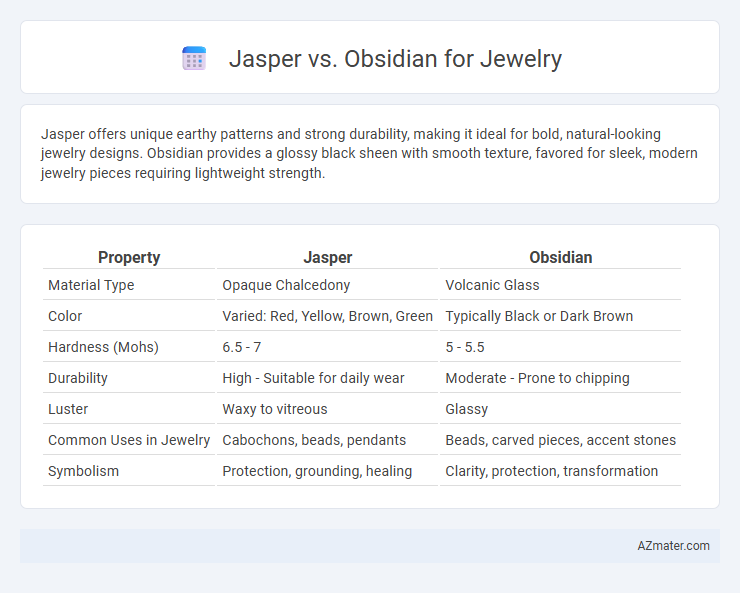Jasper offers unique earthy patterns and strong durability, making it ideal for bold, natural-looking jewelry designs. Obsidian provides a glossy black sheen with smooth texture, favored for sleek, modern jewelry pieces requiring lightweight strength.
Table of Comparison
| Property | Jasper | Obsidian |
|---|---|---|
| Material Type | Opaque Chalcedony | Volcanic Glass |
| Color | Varied: Red, Yellow, Brown, Green | Typically Black or Dark Brown |
| Hardness (Mohs) | 6.5 - 7 | 5 - 5.5 |
| Durability | High - Suitable for daily wear | Moderate - Prone to chipping |
| Luster | Waxy to vitreous | Glassy |
| Common Uses in Jewelry | Cabochons, beads, pendants | Beads, carved pieces, accent stones |
| Symbolism | Protection, grounding, healing | Clarity, protection, transformation |
Overview: Jasper vs Obsidian in Jewelry
Jasper and Obsidian are both popular gemstones used in jewelry, each offering distinct aesthetic and metaphysical properties. Jasper, an opaque and often multicolored stone, is prized for its earthy tones and patterns, providing durability and grounding energy ideal for everyday wear. Obsidian, a volcanic glass with a smooth, reflective surface, is valued for its sleek black appearance and protective qualities, making it a striking choice for bold, statement pieces.
Origins and Formation of Jasper and Obsidian
Jasper is an opaque, microcrystalline variety of quartz formed from silica-rich sediment or volcanic ash through sedimentary and hydrothermal processes, resulting in its unique patterns and colors. Obsidian is a natural volcanic glass created from rapid cooling of high-silica lava, which prevents crystal growth and produces a smooth, glassy texture commonly found near volcanic eruptions. Both stones are favored in jewelry for their distinct origins--Jasper's sedimentary complexity and Obsidian's volcanic glass clarity--offering diverse aesthetic and metaphysical qualities.
Appearance and Color Variations
Jasper displays a wide range of earthy tones including reds, browns, yellows, and greens, often featuring unique patterns and speckles that create a rich, organic appearance. Obsidian, in contrast, is predominantly deep black or dark brown with a smooth, glassy texture that offers a sleek and polished look. Jewelry made with jasper tends to emphasize natural, rustic beauty, whereas obsidian pieces highlight elegance through their glossy and uniform coloration.
Durability and Hardness Comparison
Jasper ranks at 6.5 to 7 on the Mohs scale of hardness, providing moderate durability suitable for everyday jewelry use, while Obsidian scores around 5 to 5.5, making it more prone to scratches and breakage due to its volcanic glass composition. The higher hardness of Jasper ensures better resistance to abrasion, making it a preferred choice for rings and bracelets exposed to frequent wear. In contrast, Obsidian's lower durability limits its use primarily to pendants and earrings where impact is minimal.
Symbolic Meanings and Cultural Significance
Jasper is revered in jewelry for its grounding energy and protection symbolism, often associated with stability and nurturing in many cultures, making it a popular choice for amulets and spiritual adornments. Obsidian, a volcanic glass, carries strong connotations of transformation and shielding, frequently used in rituals for its reputed ability to absorb negative energy and provide clarity. Both stones hold deep cultural significance, with Jasper linked to ancient healing traditions and Obsidian valued in Mesoamerican and Indigenous crafts for its metaphysical properties.
Common Jewelry Uses: Jasper vs Obsidian
Jasper and Obsidian are both popular in jewelry making due to their unique aesthetic and metaphysical properties. Jasper, known for its rich variety of colors and patterns, is often used in statement pieces like pendants, beads, and cabochons, prized for its durability and earthy appeal. Obsidian, valued for its glossy, glass-like texture and deep black or mahogany hues, is frequently crafted into polished beads, inlays, and protective amulets, making it a favored choice for striking, elegant jewelry designs.
Care and Maintenance of Each Stone
Jasper jewelry requires gentle cleaning with warm soapy water and a soft cloth to maintain its vibrant colors and avoid surface scratches, while it should be kept away from harsh chemicals and prolonged exposure to sunlight. Obsidian, a volcanic glass, demands careful handling to prevent chipping or cracking; clean it using mild soap and water, drying immediately to avoid water spots, and store it separately to avoid abrasion. Both stones benefit from regular inspection for damage and should be stored in padded containers to preserve their natural beauty over time.
Price Range and Market Availability
Jasper gemstones typically range from $5 to $50 per carat, making them an affordable and widely accessible choice in the jewelry market, while Obsidian pricing varies from $10 to $100 per carat depending on quality and rarity. Both stones are readily available through major jewelry retailers, but Jasper's extensive variety ensures higher market availability compared to the more niche Obsidian. The affordability and diverse supply of Jasper make it a favored option for budget-conscious buyers, whereas Obsidian appeals to those seeking distinctive volcanic glass stones with unique aesthetic properties.
How to Identify Authentic Jasper and Obsidian
Authentic jasper is identified by its unique, multicolored patterns with earthy tones and a smooth, opaque surface, often showing natural inclusions or banding. Genuine obsidian exhibits a glassy luster, sharp edges, and a uniform dark color, usually black or deep green, formed from volcanic glass cooling rapidly. Testing authenticity involves scratch tests where jasper resists scratching due to its hardness around 6.5-7, while obsidian is softer, and using magnification to check for natural imperfections rather than uniformity.
Choosing the Best Stone for Your Jewelry Style
Jasper offers a wide range of earthy tones and patterns that complement bohemian and rustic jewelry styles, enhancing its natural and organic appeal. Obsidian, with its sleek black glass-like appearance, suits modern and minimalist designs, providing a striking contrast and polished finish. Choosing between Jasper and Obsidian depends on whether you prefer the warm, vibrant aesthetics of Jasper or the bold, elegant look of Obsidian to best express your jewelry style.

Infographic: Jasper vs Obsidian for Jewelry
 azmater.com
azmater.com